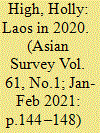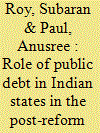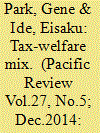|
|
|
Sort Order |
|
|
|
Items / Page
|
|
|
|
|
|
|
| Srl | Item |
| 1 |
ID:
160033


|
|
|
|
|
| Summary/Abstract |
The article is an attempt to assess India’s fiscal and external sector vulnerability in the context of the deterioration in major macroeconomic indicators in recent years. The balance sheet approach (BSA) developed mainly by the International Monetary Fund (IMF) is applied to analyse episodes of major fiscal, financial and external payment crises in developing countries between the late 1990s to early 2000. The present work assesses the vulnerability in India’s fiscal and external sectors by descriptive and comparative analyses of relevant indicators and developing a composite vulnerability index (CVI) consisting of the indicators under study. Fiscal or external sector vulnerability can also be assessed by how easily or smoothly a government or a nation can finance its budgetary deficit or rollover of debt or the external sector funding needs. The method of financing and management of debt-related liabilities become important in this context. This may get reflected in currency composition, maturity pattern and ownership pattern of liabilities. The CVI score and favourable currency composition, maturity pattern and ownership pattern of liabilities largely helped India reduce both fiscal and external sector liabilities significantly in recent years.
|
|
|
|
|
|
|
|
|
|
|
|
|
|
|
|
| 2 |
ID:
107040


|
|
|
|
|
| Publication |
London, VERSO, 2011.
|
| Description |
192p.
|
| Standard Number |
9781844676910, hbk
|
|
|
|
|
|
|
|
|
|
|
|
Copies: C:1/I:0,R:0,Q:0
Circulation
| Accession# | Call# | Current Location | Status | Policy | Location |
| 056197 | 336.3460973/DIE 056197 | Main | On Shelf | General | |
|
|
|
|
| 3 |
ID:
123165


|
|
|
|
|
| Publication |
2013.
|
| Summary/Abstract |
This paper examines the impact of military spending on general government debt in the enlarged European Union (EU) countries. For this purpose, we use panel data analysis and provide estimates from a dynamic Generalized Method of Moments (GMM) panel model. The dynamics are found to be important and the results suggest that military expenditures do have a large positive impact on the share of general government debt in the EU.
|
|
|
|
|
|
|
|
|
|
|
|
|
|
|
|
| 4 |
ID:
186162


|
|
|
|
|
| Summary/Abstract |
The fall of international oil prices by the mid-1980s and the associated economic downturn of the oil-rich countries of the Gulf represented a turning point in the economic history of Jordan, which has been historically dependent on international aid and workers’ remittances. Expansionary policies, failing to recognize the reduced inflow of external rent, led to an unprecedented rise in public debt. The situation culminated in 1989 in a deep financial crisis which induced Jordan to start a comprehensive economic reform program, inspired by the principles of the Washington Consensus. This study aims at investigating the emergence and main sources of Jordanian public debt, focusing on its external components. Based on archival research and interviews with experts, the study analyses the main reasons behind the rapid public debt increase in the second half of the 1980s and discusses its sustainability in relation to main creditor nations, negotiations with the donor community, conditionality of support, and implementation of reforms. The analysis reveals that before the 1989 crisis, there was no centralized management of public debt and debt was contracted to finance the needs of a bloated state apparatus and was not linked to comprehensive development strategies.
|
|
|
|
|
|
|
|
|
|
|
|
|
|
|
|
| 5 |
ID:
192752


|
|
|
|
|
| Summary/Abstract |
Economic costs are a central political obstacle to investing in climate change mitigation and adaptation measures. Several studies now demonstrate that as costs increase, voters are less likely to support green initiatives. In this paper we argue that opposition to government green investments is conditional on the method of financing. Notably, because public debt shifts the burden of investments into the future, it may face less public opposition than broad based taxes that require an immediate sacrifice. To test this proposition, we fielded a preregistered conjoint survey experiment on nationally representative samples in one highly indebted (Italy) and one fiscally sound country (The Netherlands). We find debt financing increases voter support for green financing by up to 10 percentage points relative to broad-based taxes. However, we find carbon taxes and wealth taxes are most preferred. These findings demonstrate that credit market tools, like green bonds and debt for climate swaps, are likely politically efficient and not just economically efficient. Where investments are already financed with debt, the findings suggest that political communication can limit a political backlash to green investments. Most importantly, the findings show that the political opposition to paying for green investments can be circumvented.
|
|
|
|
|
|
|
|
|
|
|
|
|
|
|
|
| 6 |
ID:
158162


|
|
|
|
|
| Summary/Abstract |
This article seeks to determine the effect of the amount of public debt on the long-run economic growth of the Israeli economy, using data from the years 1983–2013. The accepted economic perspective is that the influence of public debt on the economy depends on the ratio of the size of the debt to GDP. This article will also measure the influence of the size of public debt in accordance with this ratio, with the implication being that the larger the debt, the larger the ratio of debt to GDP. It will indicate that the relationship between the ratio of public debt to GDP and economic growth appears graphically as an inverted U shape. Such a relationship implies that for relatively low levels of debt to GDP ratio there is a positive effect on growth and only at higher levels of this ratio does the marginal effect become negative. The article was not able to locate the exact inflection point at which the influence becomes negative, but it can be determined that this point lies within the range of a debt to GDP ratio of 130% and greater. These results are contrary to other results which have shown that the negative influence begins at a ratio of 90%.
|
|
|
|
|
|
|
|
|
|
|
|
|
|
|
|
| 7 |
ID:
179253


|
|
|
|
|
| Summary/Abstract |
In 2020, Laos successfully contained the spread of COVID-19, with very few cases and no deaths. The key elements of the COVID-19 response reflect not only public health advice but also the core values of the political culture promoted by the ruling Lao People’s Revolutionary Party. These include unity, solidarity, struggle, respect for science, guidance by a strong center, and the extension of the state into everyday life in the form of designated roles, committees, and organizations. These significantly shaped the social fabric drawn on in the COVID-19 response. This success, then, can be read as a reaping of some of the benefits of this political culture. More ominously, the global pandemic exacerbated Lao PDR’s public debt crisis. Born of years of government backing of megaprojects such as hydropower, this debt is the dark harvest of the LPRP’s reign.
|
|
|
|
|
|
|
|
|
|
|
|
|
|
|
|
| 8 |
ID:
155298


|
|
|
|
|
| Summary/Abstract |
The aim of this paper is to study the relationship between military spending and sovereign debt in a panel of 13 European countries. In particular, under the assumption of the interdependence of military spending between US and European countries, we analyse whether US military spending affected European sovereign debt in the period 1988–2013. The empirical estimation is based on different steps: (i) a unit root test; (ii) an Arellano–Bond panel estimation and a linear fixed effect model; and (iii) a FMOLS estimation to highlight the long run relationship between debt and relevant variables. General results highlight that debt burden of European countries is: (1) positively associated with US military burden and (2) negatively associated with average military burden of other European countries.
|
|
|
|
|
|
|
|
|
|
|
|
|
|
|
|
| 9 |
ID:
193051


|
|
|
|
|
| Summary/Abstract |
The substantial amount of existing literature investigating the debt–growth association for high-income countries shows that debt has a negative impact on economic growth or the existence of an inverted U-shaped relationship between these two variables on some occasions. Given the lack of literature involving developing economies in this space, our study entirely focuses on a developing country like India. The study examines the empirical relationship between public debt (internal) and state gross domestic product (SGDP) for India in the post-reform era. The panel data extend from the year 2000 till 2020. Our random error component model findings indicate a positive and significant impact of debt in enhancing the Indian SGDPs for the above-mentioned period. Results are also confirmed by using an alternative estimation technique, namely, fixed effect. Next, we address the issue of endogeneity by employing generalized method of moments. Our results continue to remain robust. Finally, the inclusion of other control variables does not alter our findings.
|
|
|
|
|
|
|
|
|
|
|
|
|
|
|
|
| 10 |
ID:
135073


|
|
|
|
|
| Summary/Abstract |
Despite having the highest level of public debt in the Organisation for Economic Co-operation and Development (OECD), higher than Greece or Italy, Japan has one of the lowest aggregate tax burdens of the advanced industrial democracies. This paper asks why Japan, once described as a strong developmental state, has had such a weak extractive capacity, an inability to raise revenues to confront deficits and public debt? In contrast to the existing explanations that focus on political institutions, partisan preferences, or economic globalization, this article argues that Japan's ‘tax–welfare mix’ – the combination of taxes and redistributive welfare polices – undermined the state's long-term capacity to secure adequate tax revenue. More than just a source of revenue, taxes can be used directly to achieve redistributive goals, such as targeting low taxes and exemptions to specific groups. This study shows how Japan's tax–welfare mix diminished its extractive capacity through three mechanisms: the political lock-in of a redistributive social bargain struck around low taxes, the timing and sequencing of its tax policy and welfare development, and the erosion of public trust, which undermined tax consent. Beyond offering a new theory of extractive capacity, the tax–welfare mix explains aspects of Japan's tax structure that defy existing explanations and contributes to our understanding of the capitalist development state by highlighting the redistributive political function of tax policy and its long-term impact on state capacity.
|
|
|
|
|
|
|
|
|
|
|
|
|
|
|
|
|
|
|
|
|